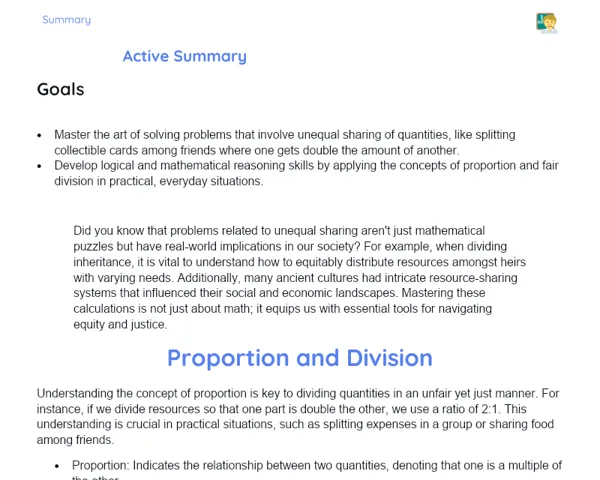Summary Tradisional | Fractions: Multiplication and Division
Contextualization
Fractions help us represent parts of a whole – an idea we often come across in our day-to-day lives. Just as we use whole numbers to count complete items, we use fractions to describe situations where we only have a part of something. For example, when a pizza is divided into eight slices, each slice is 1/8 of the entire pizza. Understanding fractions is not just important in advanced mathematics; it also plays a key role in everyday tasks like cooking, where you might need to measure ingredients accurately.
When it comes to multiplying and dividing fractions, these operations enable us to solve a variety of practical problems. Multiplying fractions is as simple as multiplying the numerators together and the denominators together. Dividing fractions, on the other hand, involves using the reciprocal of the divisor – essentially flipping the second fraction before multiplying. Such skills are very useful, whether you’re adjusting a recipe or dividing resources evenly. A good grasp of these topics not only bolsters your mathematical foundation but also equips you to handle everyday challenges with ease.
To Remember!
Multiplying Fractions
To multiply fractions, simply multiply the numerators and the denominators. For example, to multiply 2/3 by 3/4, you multiply 2 (from the first fraction) by 3 (from the second fraction) to get the numerator, and 3 by 4 to get the denominator, resulting in 6/12. This can then be simplified to 1/2 by dividing the numerator and the denominator by their greatest common divisor (in this case, 6).
Understanding how to multiply fractions becomes particularly handy in daily life. Consider a recipe that requires 3/4 of a cup of sugar, and you need to prepare just half the recipe; multiplying 3/4 by 1/2 gives you 3/8 of a cup. This process is practical not only in cooking but in other routine tasks that require proportional reasoning.
An important aspect here is the simplification of fractions after multiplication. Simplifying makes it easier to interpret and use the final answer by reducing it to the simplest form using the greatest common divisor.
-
Multiply the numerators together and the denominators together.
-
Simplify the resulting fraction by dividing by the greatest common divisor (GCD).
-
Useful in everyday situations, such as adjusting recipes.
Dividing Fractions
Dividing fractions works a bit differently from multiplying. To divide one fraction by another, you need to multiply the first fraction by the reciprocal of the second. The reciprocal is simply the result of swapping the numerator and denominator of the second fraction. For example, to divide 3/4 by 2/5, flip 2/5 to get 5/2 and then multiply it with 3/4. The final result will be 15/8, which can be simplified further if needed.
Learning how to divide fractions is quite important for more complicated problems and practical applications. Imagine you have 3/4 of a pizza and you need to share it equally among a group represented by 2/5 of the total; then you’d use division of fractions to determine the exact share for each person. This method finds its use in diverse fields—from cooking to construction work.
Just like with multiplication, simplifying the resulting fraction after division helps in making the answer clearer and easier to work with. This involves dividing both the numerator and denominator by their greatest common divisor.
-
Multiply the first fraction by the reciprocal (or flipped version) of the second fraction.
-
Simplify the resulting fraction by using the greatest common divisor (GCD).
-
Highly useful for everyday applications, such as dividing portions equally.
Simplifying Fractions
Simplifying fractions means reducing them to their simplest form by dividing the numerator and the denominator by their greatest common divisor (GCD). This process makes fractions easier to understand and use. For instance, the fraction 8/12 can be simplified by dividing both numbers by 4 (the GCD) to give 2/3.
Being able to simplify fractions is a key skill that not only makes future calculations simpler but also minimizes the chances of error. For example, instead of multiplying 4/6 by 3/9 directly, simplifying each fraction first – turning them into 2/3 and 1/3 respectively – can lead to an easier multiplication process.
Simplified fractions also allow for easier comparison and understanding, which is very practical when measuring ingredients or dividing resources in everyday situations.
-
Divide the numerator and denominator by their greatest common divisor (GCD).
-
Helps streamline subsequent calculations and reduces errors.
-
Makes the final results clearer and easier to interpret.
Practical Applications
Multiplying and dividing fractions have numerous applications in our daily lives. In cooking, for example, you may need to tweak a recipe for a different number of servings. If a recipe calls for 3/4 of a cup of sugar but you only want half the recipe, multiplying 3/4 by 1/2 gives you 3/8 of a cup of sugar. Such adjustments are common in everyday kitchen work.
In construction, accurate measurements are crucial. For instance, if you have a piece of wood that is 5/8 of a metre long and need to split it into equal parts for a project, the division of fractions helps determine the correct lengths for each segment. This ensures precision and efficiency in execution.
Similarly, in music, fractions are used to denote the duration of notes. A quarter note, for example, represents 1/4 of a full note and an eighth note represents 1/8. This is fundamental for musicians who learn to read and perform music accurately.
-
Adjust recipes for different serving sizes.
-
Calculate precise measurements in construction projects.
-
Understand the duration of musical notes in sheet music.
Key Terms
-
Multiplying Fractions: An operation where the numerators of the fractions are multiplied together and the denominators are multiplied together.
-
Dividing Fractions: An operation involving the multiplication of the first fraction by the reciprocal of the second fraction.
-
Simplifying Fractions: The process of reducing a fraction to its simplest form by dividing the numerator and denominator by their greatest common divisor (GCD).
-
Reciprocal Fractions: Fractions obtained by interchanging the numerator and denominator.
-
Practical Problems: These include everyday situations — like cooking, measurement, or interpreting music — where fraction operations are applied.
Important Conclusions
In today’s lesson, we delved into the multiplication and division of fractions, highlighting their importance in solving practical problems encountered in daily life. We learnt that multiplying fractions involves directly multiplying the numerators and denominators, while division requires us to use the reciprocal of the divisor. These concepts form the basis for solving many everyday problems – be it in the kitchen, in construction work, or even in music.
We also discussed the significance of simplifying fractions after performing these operations, which makes our results easier to understand and use. This method not only makes computation smoother but also helps in accurately interpreting data in practical scenarios.
Overall, understanding the multiplication and division of fractions is a fundamental skill. It provides a solid foundation for further studies in mathematics as well as for handling various real-life challenges with confidence.
Study Tips
-
Revisit the class examples and problems to reinforce your understanding of fraction operations.
-
Practice simplifying fractions at home with more exercises and practical problems to build your confidence.
-
Look out for everyday applications of fractions, like adjusting recipes or measuring items, to appreciate the relevance of these mathematical concepts.



